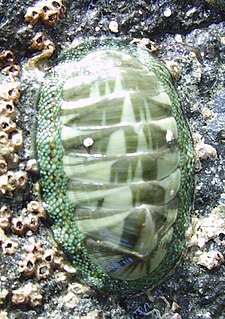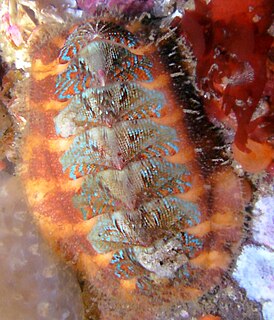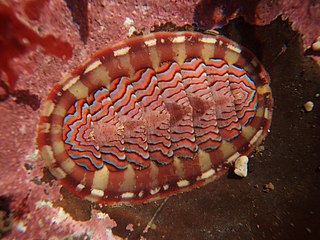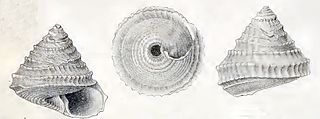The radula is an anatomical structure used by mollusks for feeding, sometimes compared to a tongue. It is a minutely toothed, chitinous ribbon, which is typically used for scraping or cutting food before the food enters the esophagus. The radula is unique to the molluscs, and is found in every class of mollusc except the bivalves, which instead use cilia, waving filaments that bring minute organisms to the mouth.

Chitons are marine molluscs of varying size in the class Polyplacophora, formerly known as Amphineura. About 940 extant and 430 fossil species are recognized.

The gumboot chiton, also known as the giant western fiery chiton or giant Pacific chiton, is the largest of the chitons, growing to 36 cm (14 in) and capable of reaching a weight of more than 2 kg (4.4 lb). It is found along the shores of the northern Pacific Ocean from Central California to Alaska, across the Aleutian Islands to the Kamchatka Peninsula and south to Japan. It inhabits the lower intertidal and subtidal zones of rocky coastlines. The gumboot chiton's appearance has led some tidepoolers to refer to it, fondly, as the "wandering meatloaf". The name "gumboot chiton" seems to derive from a resemblance to part of a rubber Wellington boot or "gum rubber" boot.

Chiton glaucus, common name the green chiton or the blue green chiton, is a species of chiton, a marine polyplacophoran mollusk in the family Chitonidae, the typical chitons. It is the most common chiton species in New Zealand. Chiton glaucus is part of a very primitive group of mollusc with evidence of being present in up to 80 million years of the fossil record.

Sypharochiton pelliserpentis is a species of chiton in the family Chitonidae. As the species name suggests, the surface of the girdle in this chiton has a pattern of overlaying scales resembling snakeskin.

Acanthochitona zelandica is a species of chiton in the family Acanthochitonidae, also sometimes known as the hairy, or "tufted," chiton. It probably developed during the mid to late Pleistocene, and is endemic to New Zealand.

Tonicella lineata, commonly known as the lined chiton, is a species of chiton from the North Pacific.

Tonicella undocaerulea, commonly known as the blue lined chiton, is a species of chiton.

Mopalia spectabilis, commonly known as the red-flecked mopalia, is a species of chiton.

Tonicella lokii, commonly known as the flame lined chiton or Loki's chiton, is a chiton in the lined chiton genus Tonicella.

Acanthopleura granulata, common name the West Indian fuzzy chiton, is a medium-sized tropical species of chiton. This type of chiton's activity does not depend on spring-neap oscillations leading to lower locomotion loss. Its morphology is different from usual chitons as it has a fifth valve, which is split into halves.

Acanthochitonidae is a family of chitons, marine molluscs in the class Polyplacophora.
Mopalia ciliata is a chiton in the genus Mopalia, commonly known as the hairy chiton. It is a medium-sized marine mollusc up to 5.0 cm in length. It is oval shaped with 8 separate moderately elevated, overlapping ridged valves on its dorsal surface. It resides along the coast of North America.

Carenzia melvilli is a species of extremely small deep water sea snail, a marine gastropod mollusk in the family Seguenziidae.

Plaxiphora albida, the white Plaxiphora chiton, is a species of chiton in the family Mopaliidae.

Chiton olivaceus, the green chiton, is a species of chiton, a marine polyplacophoran mollusk in the family Chitonidae, the typical chitons.
Plaxiphora egregia is a distinctive chiton in the family Mopaliidae, endemic to the South Island of New Zealand, where it is uncommon.

Plaxiphora biramosa is an uncommon chiton in the family Mopaliidae, endemic to New Zealand.

Acanthochitona garnoti, the spiny chiton, is a medium-sized polyplacophoran mollusc in the family Acanthochitonidae, found on the coast of southern Africa.

Acanthochitona crinita is a species of marine chiton in the family Acanthochitonidae. It is found on rocky coasts in the northeastern Atlantic Ocean, the North Sea and the Mediterranean Sea.















